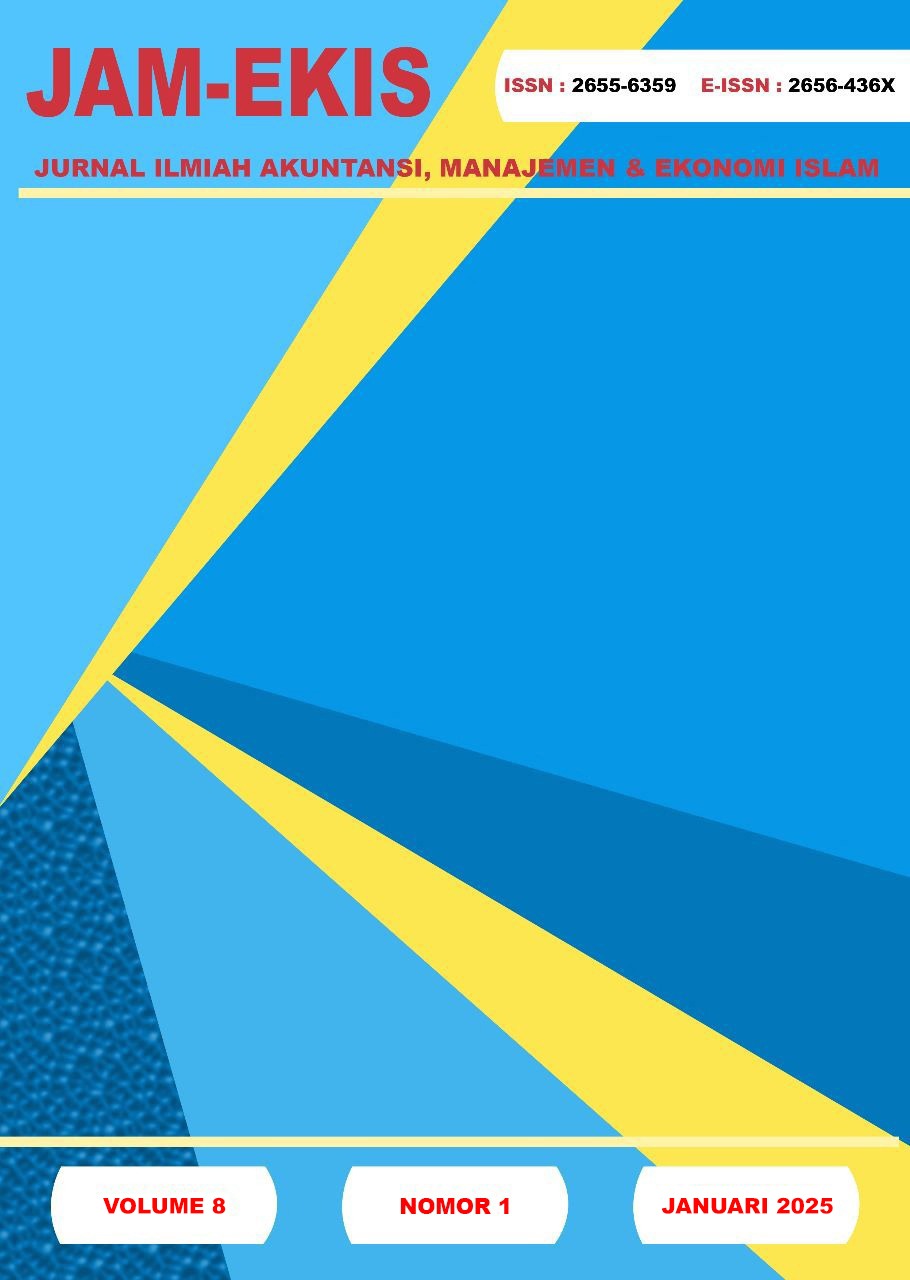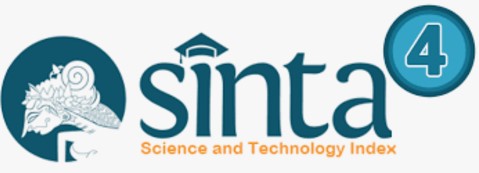A COMPREHENSIVE ANALYSIS OF THE DETERMINANTS OF INCOME INEQUALITY OVER THE PAST DECADE IN INDONESIA “PANEL DATA APPROACH”
DOI:
https://doi.org/10.36085/jamekis.v8i1.7686Abstrak
Income inequality is a serious challenge facing the world, including Indonesia. This study aims to analyze the factors affecting income inequality in Indonesia from 2014 to 2023, using panel data from 34 provinces. The random effect model (REM) regression method assesses the impact of economic, social, and geographic variables on income distribution. The results show that economic growth significantly impacts inequality, while GRDP per capita and domestic investment have a significant negative impact. Factors such as population and education also have a positive effect on inequality, while poverty has no significant effect. The results support the Kuznets Curve hypothesis, which states that inequality increases in the early stages of development, increased equitable investment, and access to education as efforts to reduce income inequality. By promoting inclusive growth this study contributes to a deeper understanding of the dynamics of inequality in Indonesia.
Referensi
Acemoglu, D., & Restrepo, P. (2019). Artificial Intelligence, Automation, and Work. The Economics of Artificial Intelligence, 1(1), 197–236. https://doi.org/10.7208/chicago/9780226613475.003.0008
Acheampong, A. O., Dzator, J., & Shahbaz, M. (2021). Empowering the powerless: Does access to energy improve income inequality? Energy Economics, 99. https://doi.org/10.1016/j.eneco.2021.105288
Agus Triono, T., Candra Sangaji, R., Program, D., & Bisnis dan Ekonomi, F. (2023). Faktor Mempengaruhi Tingkat Kemiskinan di Indonesia: Studi Literatur Laporan Data Kemiskinan BPS Tahun 2022. https://www.bk3s.org/ojs/index.php/jsb
Ahmad, A., Wahyudi, H., & Lestari, W. R. (2024). The Effect of GDP Per Capita, Population, and Income Inequality on CO2 Emissions in Indonesia. International Journal of Energy Economics and Policy, 14(1), 365–370. https://doi.org/10.32479/ijeep.15224
Akshita Sheoran. (2024). Exploring the causes and consequences of income inequality in India. Innovative Research Thoughts, 10(2), 92–102. https://doi.org/10.36676/irt.v10.i2.1412
Al Aqilah, M. R., Muchtar, M., & Robinson Sihombing, P. (2024). Analisis Determinan Ketimpangan Pendapatan Di Pulau Sumatera. Journal of Law, Administration, and Social Science, 4(1), 13–24. https://doi.org/10.54957/jolas.v4i1.684
Ananda, A. R. O. R., & Prabowo, P. S. (2021). (Analisis Disparitas Pendapatan Dan Pengujian Hipotesis Kuznet Di Provinsi Jawa Timur Tahun 2011-2019). Independent: Journal of Economics, 1(2), 196–205. https://doi.org/10.26740/independent.v1n2.p196-205
Anasta, A., & Sylviana, W. (2024). Analysis of Income Inequality in ASEAN Countries. Jurnal Ilmu Ekonomi Terapan, 9(1), 64–78. https://doi.org/10.20473/jiet.v9i1.53554
Ariefianto, Moch. D. (2012). EKONOMETRIKAesensi dan aplikasi dengan menggunakan EViews (I. N. Sallama, Ed.; 1st ed.). Penerbit Erlangga.
Azam, M., & Raza, S. A. (2018a). Financial sector development and income inequality in ASEAN-5 countries: Does financial Kuznets curve exists? Global Business and Economics Review, 20(1), 88–114. https://doi.org/10.1504/GBER.2018.088482
Azam, M., & Raza, S. A. (2018b). Financial sector development and income inequality in ASEAN-5 countries: Does financial Kuznets curve exists? Global Business and Economics Review, 20(1), 88–114. https://doi.org/10.1504/GBER.2018.088482
Baskoro, H. A., Santoso, D. B., & Pangestuty, F. W. (2024). Determinants of Income Inequality in Indonesia. Proceedings of the 1st International Conference on Social Science (ICSS), 3(2), 280–284. https://doi.org/10.59188/icss.v3i2.209
BPS. (2024). Gini Ratio Menurut Provinsi dan Daerah, 2024. Badan Pusat Statistik. https://www.bps.go.id/id/statistics-table/2/OTgjMg==/gini-rasio--maret-2024.html
Chatra, A., Suryaningrum, Ayu, D., Yuliana, Made, Ayuk, Taman, N., Retnowati, D., Damayanti, F., Langoday, Ola, T., I Gusti Ayu Made Agung Mas Andriani, P., Muhammad Ridha, I., Anita, A., & I Gusti Ayu Lia, Y. (2019). PENGANTAR EKONOMI PEMBANGUNAN (SEPRIANO & EFITRA, Eds.; 1st ed.). PT. Sonpedia Publishing Indonesia.
Dai, S. S. I., Canon, S., & Bauty, D. O. (2023). Analisis Pengaruh Rls, Pengeluaran Perkapita, Uhh, Dan Tingkat Kemiskinan Terhadap Ketimpangan Distribusi Pendapatan Di Kbi Dan Kti. Jesya, 6(1), 535–544. https://doi.org/10.36778/jesya.v6i1.950
Demand, C. (2023). ANALYSIS OF DETERMINANTS OF INCOME DISTRIBUTION INEQUALITY IN INDONESIA. 4, 1–9.
DPMPTSP. (2023, July 31). Perubahan Penanaman Modal Asing Dalam Negeri Menjadi Penanaman Modal Asing. Dinas Penanaman Modal Dan Pelayanan Terpadu Satu Pintu. https://dpmptsp.bantenprov.go.id/berita/perubahan-penanaman-modal-asing-dalam-negeri-menjadi-penanaman-modal-asing
Hartini, N. T. (2017). Pengaruh Pdrb Per Kapita, Investasi Dan Ipm Terhadap Ketimpangan Pendapatan Antar Daerah Di Provinsi Diy Tahun 2011-2015. Jurnal Pendidikan Dan Ekonomi, 6(6), 530–539.
Hidayat, M., & Karimi, S. (2020). Inequality, Economic Growth, and Redistribution; Literature Review. In Jurnal Akuntansi & Ekonomika (Vol. 10, Issue 1). https://doi.org/https://doi.org/10.37859/jae.v10i1.1952
Janah, M. (2022). Analisis Pengaruh Tingkat Pdrb Perkapita, Indeks Pembangunan Manusia, Dan Penanaman Modal Asing Terhadap Ketimpangan Pendapatan Di Indonesia Periode Tahun 2019-2021. Profit: Jurnal Manajemen, Bisnis Dan Akuntansi, 1(4), 23–43. https://doi.org/10.58192/profit.v1i4.183
Julihanza, A., & Khoirudin, R. (2023). Determinan Ketimpangan Pendapatan di Seluruh Provinsi di Sumatera. Journal of Macroeconomics and Social Development, 1(2), 1–12. https://doi.org/10.47134/jmsd.v1i2.93
Kavya, T. B., & Shijin, S. (2020). Economic development, financial development, and income inequality nexus. Borsa Istanbul Review, 20(1), 80–93. https://doi.org/10.1016/j.bir.2019.12.002
Lestari, F., Olilingo, F. Z., & Mopangga, H. (2024). Analisis Ketimpangan Pendapatan Di Provinsi Gorontalo Tahun 2018 – 2022. Equilibrium : Jurnal Ilmiah Ekonomi, Manajemen Dan Akuntansi, 13(2), 306. https://doi.org/10.35906/equili.v13i2.2003
Lindiasari, P., & Ramadhani, W. A. (2019). EFEKTIFITAS BANTUAN SOSIAL DALAM PENANGGULANGAN KEMISKINAN DI TENGAH PERLAMBATAN EKONOMI INDONESIA DENGAN PENDEKATAN NON- PARAMETRIK. JURNAL PERSPEKTIF EKONOMI DARUSSALAM, 5(1), 9–31. https://doi.org/doi.org/10.24815/jped.v5i1.14227
Lutfiani, D., & Yuniasih, A. F. (2021). Pengaruh Disparitas Capaian Pendidikan Terhadap Disparitas Distribusi Pendapatan Di Indonesia Tahun 2012-2019. Seminar Nasional Official Statistics, 2020(1), 662–671. https://doi.org/10.34123/semnasoffstat.v2020i1.467
Maesza, P., Saputro, G. E., & Suwarno, P. (2022). Pengaruh Anggaran Pertahanan, Pertumbuhan Ekonomi, dan Investasi Terhadap Ketimpangan Pendapatan di Indonesia Tahun 2000-2019. Jurnal Cafetaria, 3(1), 130–140.
Maneejuk, P., Yamaka, W., & Sriboonchitta, S. (2021). Does the Kuznets curve exist in Thailand? A two decades’ perspective (1993–2015). Annals of Operations Research, 300(2), 545–576. https://doi.org/10.1007/s10479-019-03425-6
Nunoo, J., Taale, F., Ofori, I. K., Mwinlaaru, P. Y., & Adama, A. Y. S. (2024). Human capital and income inequality in Africa: robust governance synergies and thresholds. Cogent Economics and Finance, 12(1). https://doi.org/10.1080/23322039.2024.2417757
Nursahid, E., & Mintarti, S. (2018). Analisis faktor yang mempengaruhi ketimpangan pendapatan di Indonesia Analysis of factors influencing income inequality in Indonesia. Jurnal Ilmu Ekonomi Mulawarman (JIEM), 3(1). http://journal.feb.unmul.ac.id/index.php/JIEM
Owolabi, O. A., Omeire, M. C., Okwudire, B. O., & Bolujoko, O. T. (2024). Education, Electricity Access, and Income Inequality in Nigeria. International Journal of Energy Economics and Policy, 14(5), 149–161. https://doi.org/10.32479/ijeep.16868
Panggarti, U., Zumaeroh, Z., Dwi Purnomo, S., Retnowati, D., & Adhitya, B. (2022). Studi komparatif ketimpangan antar pulau di Indonesia. Forum Ekonomi, 24(2), 288–298. https://doi.org/10.30872/jfor.v24i2.10988
Piętak, Ł. (2014). Review Of Theories And Models Of Economic Growth. Comparative Economic Research. Central and Eastern Europe, 17(1), 45–60. https://doi.org/10.2478/cer-2014-0003
Purusa, N. A., Kurniawan, R., & Aqmala, D. (2024). Analysis of economic development and income inequality in Kedungsepur Strategic Area, Indonesia. Multidisciplinary Science Journal, 7(1), 1–6. https://doi.org/10.31893/multiscience.2025013
Rahmawati, Dwi. E., Hadi Priyono, T., Kurnia Lestari, E., Wahyu, Prianto, F., Yunitasari, U., & Munir, A. (2024). Analisis Determinan Ketimpangan Pendapatan Di Indonesia. Journal of Law, Administration, and Social Science, 4(1), 13–24. https://doi.org/10.54957/jolas.v4i1.684
Rifkhan. (2022). MEMBACA HASIL REGRESI DATA PANEL (M. Dewi, Ed.; 1st ed.). Cipta Media Nusantara.
Sari, Y., Soleh, A., & Wafiaziza, W. (2021). Analisis Pengaruh Pendidikan Dan Penduduk Miskin Terhadap Ketimpangan Pendapatan Di Provinsi Jambi. Journal Development, 9(2), 169–180. https://doi.org/10.53978/jd.v9i2.182
Setiawan, M. B., Nawatmi, S., & Nusantara, A. (2024). Income Inequality – Empirical Study of 34 Provinces in Indonesia. Jesya, 7(2), 1812–1822. https://doi.org/10.36778/jesya.v7i2.1677
Silalahi, S. M., Sitorus, H., Hasanah, I., & Tobing, P. Y. (2024). Pengaruh Jumlah Penduduk yang Bekerja dan Investasi Terhadap Ketimpangan Distribusi Pendapatan. JALAKOTEK: Journal of Accounting Law Communication and Technology, 1(2), 557–568. https://doi.org/10.57235/jalakotek.v1i2.2549
Suratman, E., Mayudi, G., & Hayet. (2022). Impact of Inflation and Exchange Rate on Asean Income Inequality. International Journal of Business and Society, 23(1), 390–403. https://doi.org/10.33736/ijbs.4621.2022
Vo, D. H., Pham, A. T., Tran, Q., & Vu, N. T. (2023). The long-run effects of financial development on income inequality: Evidence from the Asia-Pacific countries. Heliyon, 9(8), e19000. https://doi.org/10.1016/j.heliyon.2023.e19000
Weber, A. (2024). Effect of Economic Policies on Income Inequality: A Comparative Study of Switzerland and Bolivia. 9(5), 66–81. www.iprjb.org
Wijayanti, D., & Putri, I. D. N. (2023). Analisis determinan ketimpangan pendapatan di Pulau Jawa tahun 2017-2022. Jurnal Kebijakan Ekonomi Dan Keuangan, 2(2), 126–134. https://doi.org/10.20885/jkek.vol2.iss2.art2
Yusuf, A. A., Anglingkusumo, R., & Sumner, A. (2021). A direct test of Kuznets in a developing economy: a cross-district analysis of structural transformation and inequality in Indonesia. Regional Studies, Regional Science, 8(1), 184–206. https://doi.org/10.1080/21681376.2021.1924850
Zulkarnain, A., & Satrianto, A. (2023). The Effect of Financial Literacy and Financial Inclusion on Income Inequality in Indonesia. Jurnal Ekonomi Pembangunan, 21(02), 179–188. https://doi.org/10.22219/jep.v21i02.29327







